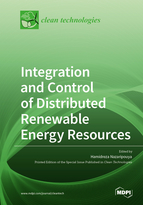Integration and Control of Distributed Renewable Energy Resources
A special issue of Clean Technologies (ISSN 2571-8797).
Deadline for manuscript submissions: closed (31 May 2021) | Viewed by 25727
Special Issue Editor
2. Department of Electrical and Computer engineering, University of California, Riverside (UCR), Riverside, CA 92507, USA
Interests: power systems and smart grid; power electronics; control and optimization; microgrid; energy storage; renewable energy
Special Issue Information
Dear colleagues,
Distributed renewable energy resources have recently gained significant attention due to the exploitation and promotion of clean and abundant energy resources. This tendency is expected to increase more rapidly, partly driven by environmental concerns and the urgent need for reductions in carbon emissions. However, there are still several technical challenges regarding the deployment of distributed renewable energy resources. Technical concerns associated with integration and control of distributed renewable energy resources include but are not limited to optimal placement, communication barriers, optimal operation in grid-connected and islanded modes as well as the impact of these resources on power quality, power system security, stability, and protection systems.
This Special Issue will address all aspects related to the integration and control of distributed renewable energy resources. It aims to understand the existing challenges and explore new solutions and practices for overcoming technical challenges.
We invite all researchers and professionals from the area of renewable energy resources, control, and optimization to submit interesting articles to this Special Issue of the Clean Technologies journal. It is recommended to send a tentative title and a short summary of the manuscript to Clean Technologies Editor Mr. Hanson Sun <[email protected]>.
Dr. Hamidreza Nazaripouya
Guest Editor
Manuscript Submission Information
Manuscripts should be submitted online at www.mdpi.com by registering and logging in to this website. Once you are registered, click here to go to the submission form. Manuscripts can be submitted until the deadline. All submissions that pass pre-check are peer-reviewed. Accepted papers will be published continuously in the journal (as soon as accepted) and will be listed together on the special issue website. Research articles, review articles as well as short communications are invited. For planned papers, a title and short abstract (about 100 words) can be sent to the Editorial Office for announcement on this website.
Submitted manuscripts should not have been published previously, nor be under consideration for publication elsewhere (except conference proceedings papers). All manuscripts are thoroughly refereed through a single-blind peer-review process. A guide for authors and other relevant information for submission of manuscripts is available on the Instructions for Authors page. Clean Technologies is an international peer-reviewed open access quarterly journal published by MDPI.
Please visit the Instructions for Authors page before submitting a manuscript. The Article Processing Charge (APC) for publication in this open access journal is 1600 CHF (Swiss Francs). Submitted papers should be well formatted and use good English. Authors may use MDPI's English editing service prior to publication or during author revisions.
Keywords
- Renewable energy resources (RES)
- Distributed generation (DG)
- Clean energy
- Modeling and design
- Control and optimization
- Interconnection, operation, and planning






